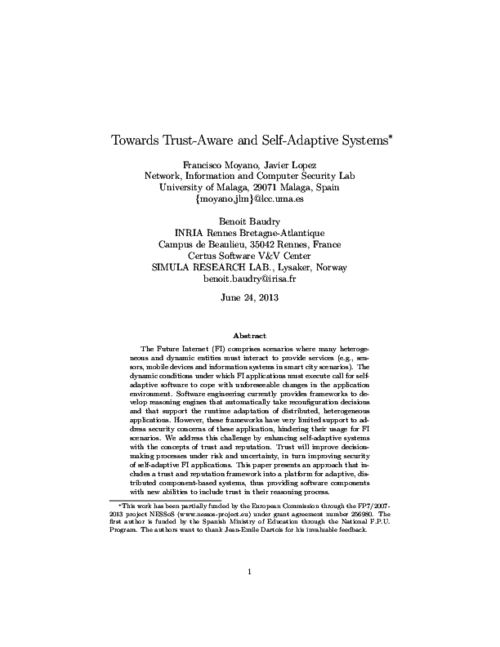 ] Type Year
] Type Year XVI Jornadas de Ingeniería del Software y Bases de Datos (JISBD 2011), Servizo de publicacións da Universidade da Coruña, pp. 487-491, 2011.
Abstract
Developing software through systematic processes is becoming more and more important due to the growing complexity of software development. It is important that the development process used integrates security aspects from the first stages at the same level as other functional and non-functional requirements. The identification of security aspects in the first stages ensures a more robust development and permits the security requirements to be perfectly coupled with the design and the rest of the system’s requirements. Systems which are based on Grid Computing are a kind of systems that have clear differentiating features in which security is a highly important aspect. Generic development processes are sometimes used to develop Grid specific systems without taking into consideration either the subjacent technological environment or the special features and particularities of these specific systems. In fact, the majority of existing Grid applications have been built without a systematic development process and are based on ad hoc developments.
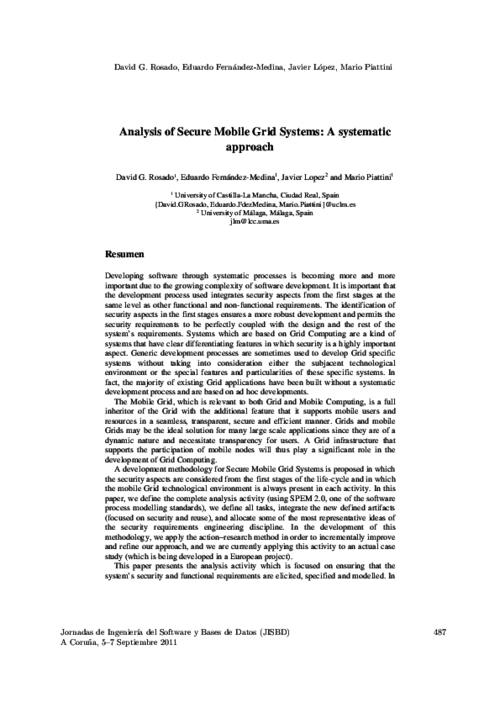
Information and Software Technology, vol. 52, Elsevier, pp. 517-536, May 2010. DOI
Abstract
Developing software through systematic processes is becoming more and more important due to the growing complexity of software development. It is important that the development process used integrates security aspects from the first stages at the same level as other functional and non-functional requirements. Systems which are based on Grid Computing are a kind of systems that have clear differentiating features in which security is a highly important aspect. The Mobile Grid, which is relevant to both Grid and Mobile Computing, is a full inheritor of the Grid with the additional feature that it supports mobile users and resources. A development methodology for Secure Mobile Grid Systems is proposed in which the security aspects are considered from the first stages of the life-cycle and in which the mobile Grid technological environment is always present in each activity. This paper presents the analysis activity, in which the requirements (focusing on the grid, mobile and security requirements) of the system are specified and which is driven by reusable use cases through which the requirements and needs of these systems can be defined. These use cases have been defined through a UML-extension for security use cases and Grid use cases which capture the behaviour of this kind of systems. The analysis activity has been applied to a real case.
8th International Workshop on Security and Trust Management (STM 2012), A. Jøsang, P. Samarati, and M. Petrocchi Eds., LNCS 7783, Springer, pp. 113-128, 2013. DOI
Abstract
During the last years, many trust and reputation models have been proposed, each one targeting different contexts and purposes, and with their own particularities. While most contributions focus on defining ever-increasing complex models, little attention has been paid to the process of building these models inside applications during their implementation. The result is that models have traditionally considered as ad-hoc and after-the-fact solutions that do not always fit with the design of the application. To overcome this, we propose an object-oriented development framework onto which it is possible to build applications that require functionalities provided by trust and reputation models. The framework is extensible and flexible enough to allow implementing an important variety of trust models. This paper presents the framework, describes its main components, and gives examples on how to use it in order to implement three different trust models.
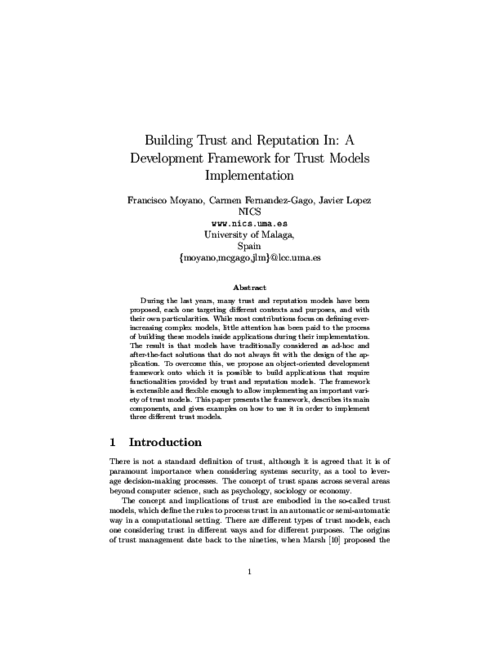
8th International Conference on Availability, Reliability and Security, IEEE, pp. 121-130, Nov 2013. DOI
Abstract
The number of insider threats hitting organizations and big enterprises is rapidly growing. Insider threats occur when trusted employees misuse their permissions on organizational assets. Since insider threats know the organization and its processes, very often they end up undetected. Therefore, there is a pressing need for organizations to adopt preventive mechanisms to defend against insider threats. In this paper, we propose a framework for insiders identification during the early requirement analysis of organizational settings and of its IT systems. The framework supports security engineers in the detection of insider threats and in the prioritization of them based on the risk they represent to the organization. To enable the automatic detection of insider threats, we extend the SI* requirement modeling language with an asset model and a trust model. The asset model allows associating security properties and sensitivity levels to assets. The trust model allows specifying the trust level that a user places in another user with respect to a given permission on an asset. The insider threats identification leverages the trust levels associated with the permissions assigned to users, as well as the sensitivity of the assets to which access is granted. We illustrate the approach based on a patient monitoring scenario.
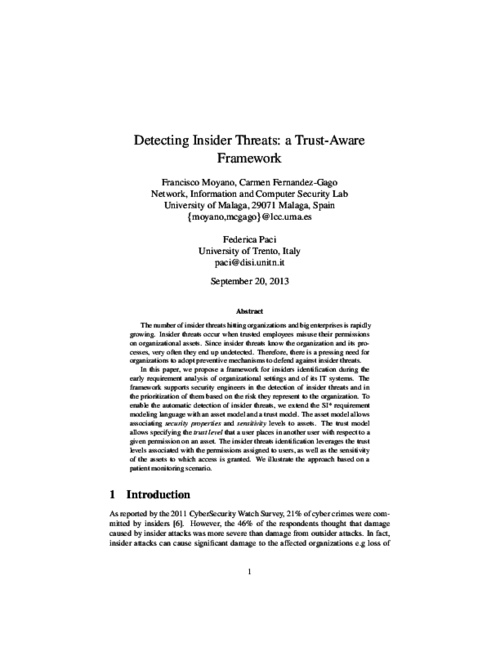
Journal of Universal Computer Science, vol. 16, no. 17, Springer, pp. 2333-2352, Sep 2010. DOI
Abstract
The idea of developing software through systematic development processes toimprove software quality is not new. Nevertheless, there are still many information systemssuch as those of Grid Computing which are not developed through methodologies that areadapted to their most differentiating features. A systematic development process for Gridsystems that supports the participation of mobile nodes and incorporates security aspects intothe entire software lifecycle will thus play a significant role in the development of systemsbased on Grid computing. We are creating a development process for the construction ofinformation systems based on Grid Computing, which is highly dependent on mobile devices,in which security plays a highly important role. One of the activities in this process is that ofanalysis which is focused on ensuring that the system’s security and functional requirements areelicited, specified and modelled. In our approach, this activity is driven by use cases andsupported by the reusable repository. This obtains, builds, defines and refines the use cases ofthe secure Mobile Grid systems which represent the functional and non-functional requirementsof this kind of systems. In this paper, we present the proposed development process throughwhich we introduce the main aspects of the UML profile defined for building use case diagramsin the mobile Grid context through which it is possible to represent specific mobile Gridfeatures and security aspects, showing in detail how to build use case diagrams for a real mobile Grid application by using our UML profile, denominated as GridUCSec-Profile.
Third International Conference on Software and Data Technologies (ICSOFT’08), Springer, pp. 146-151, 2008.
Abstract
The interest to incorporate mobile devices into Grid systems has arisen with two main purposes. The firstone is to enrich users of these devices while the other is that of enriching the own Grid infrastructure.Security of these systems, due to their distributed and open nature, is considered a topic of great interest. Aformal approach to security in the software life cycle is essential to protect corporate resources. However,little attention has been paid to this aspect of software development. Due to its criticality, security should beintegrated as a formal approach into the software life cycle. We are developing a methodology ofdevelopment for secure mobile Grid computing based systems that helps to design and build secure Gridsystems with support for mobile devices directed by use cases and security use cases and focused onservice-oriented security architecture. In this paper, we will present one of the first steps of ourmethodology consisting of analyzing security requirements of mobile grid systems. This analysis will allowus to obtain a set of security requirements that our methodology must cover and implement.
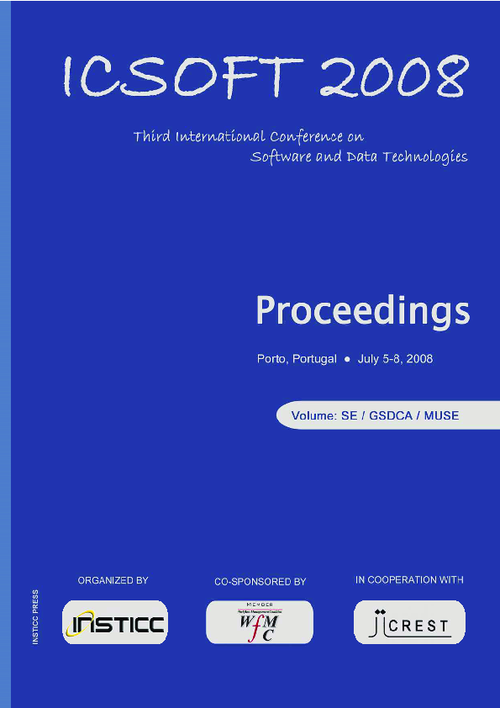
IV Congreso Iberoamericano de Seguridad Informática (CIBSI’07), Sebastián Cañón, M.A., pp. 111-124, 2007.
International Conference on Availability, Reliability and Security (ARES’08), IEEE Computer Society, pp. 136-143, 2008.
Abstract
A Grid computing system is defined as a platformthat supports distributed system applications which require fastaccess to a large quantity of distributed resources in acoordinated manner. With the development of wirelesstechnology and mobile devices, the Grid becomes the perfectcandidate so that mobile users can make complex works that addnew computational capacity to the Grid. Security of thesesystems, due to their distributed and open nature, receives greatinterest. The growing size and profile of the grid requirecomprehensive security solutions as they are critical to thesuccess of the endeavour. A formal approach to security in thesoftware life cycle is essential to protect corporate resources.However, little thought has been given to this aspect of softwaredevelopment. Due to its criticality, security should be integratedas a formal approach in the software life cycle. A methodology ofdevelopment for secure mobile Grid computing based systems isdefined, that is to say, an engineering process that defines thesteps to follow so that starting from the necessities to solve, wecan design and construct a secure Grid system with support formobile devices that is able to solve and cover these necessities.
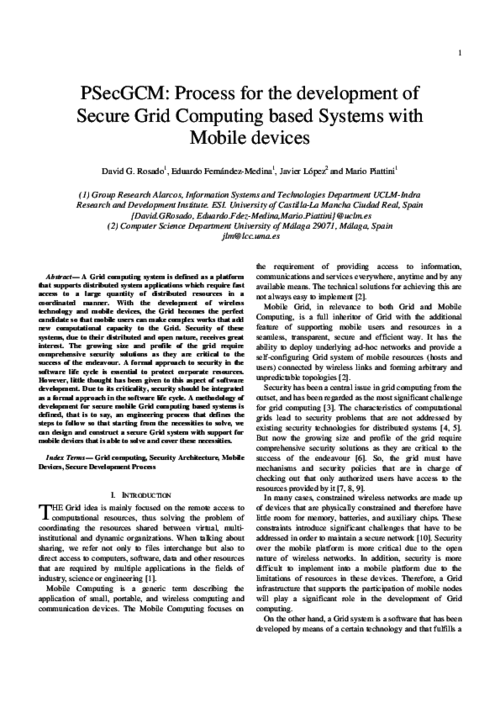
Journal of Network and Computer Applications, vol. 34, Elsevier, pp. 1168-1183, 2011.
Abstract
Grid computing has arisen as an evolution of distributed systems mainly focused on the sharing of and remote access to resources in a uniform, transparent, secure, efficient and reliable manner. It is possible to join Grid technology and mobile technology in order to create one of the most promising technologies and developments to appear in recent years, in that they enrich one another and provide new solutions that solve many of the limitations and problems found in different technologies. Security is a very important factor in Mobile Grid Computing and is also difficult to achieve owing to the open nature of wireless networks and heterogeneous and distributed environments. Success in obtaining a secure system originates in incorporating security from the first stages of the development process. It has therefore been necessary to define a development process for this kind of systems in which security is incorporated in all stages of the development and the features and particularities of the Mobile Grid systems are taken into consideration. This paper presents one of the activities of this development process, the design activity, which consists of defining and designing a security software architecture. This architecture will be built from a security architecture, defined as reference architecture, in which security services, interfaces and operations are defined with the purpose of defining a reference security architecture which covers the majority of security requirements identified in the analysis activity. The design activity will build the system architecture that will be the input artefact for the subsequent activity in the process, which is the construction activity.
IEICE Trans. on Information and Systems, vol. E94-D, IEICE, pp. 243-254, Feb 2011. DOI
Abstract
The systematic processes exactly define the development cycle and help the development team follow the same development strategies and techniques, thus allowing a continuous improvement in the quality of the developed products. Likewise, it is important that the development process used integrates security aspects from the first stages at the same level as other functional and non-functional requirements. Grid systems allow us to build very complex information systems with different and remarkable features (interoperability between multiple security domains, cross-domain authentication and authorization, dynamic, heterogeneous and limited mobile devices, etc). With the development of wireless technology and mobile devices, the Grid becomes the perfect candidate for letting mobile users make complex works that add new computational capacity to the Grid. A methodology of development for secure mobile Grid systems is being defined. One of the activities of this methodology is the requirements analysis which is based in reusable use cases. In this paper, we will present a UML-extension for security use cases and Grid use case which capture the behaviour of this kind of systems. A detailed description of all these new use cases defined in the UML extension is necessary, describing the stereotypes, tagged values, constraints and graphical notation. We show an example of how to apply and use this extension for building the diagram of use cases and incorporating common security aspects for this kind of systems. Also, we will see how the diagrams built can be reused in the construction of others diagrams saving time and effort in this task.
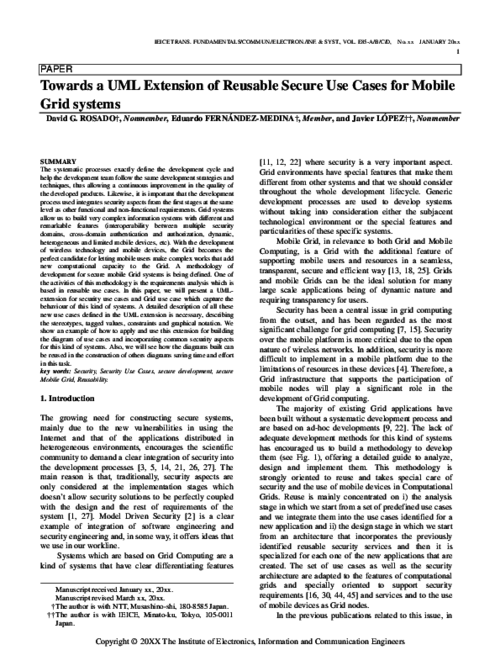
7th IFIP WG 11.11 International Conference on Trust Management (IFIPTM 2013), C. Fernandez-Gago, I. Agudo, F. Martinelli, and S. Pearson Eds., AICT 401, Springer, pp. 255-262, Jun 2013. DOI
Abstract
The Future Internet (FI) comprises scenarios where many heterogeneous and dynamic entities must interact to provide services (e.g., sensors, mobile devices and information systems in smart city scenarios). The dynamic conditions under which FI applications must execute call for self-adaptive software to cope with unforeseeable changes in the application environment. Software engineering currently provides frameworks to develop reasoning engines that automatically take reconfiguration decisions and that support the runtime adaptation of distributed, heterogeneous applications. However, these frameworks have very limited support to address security concerns of these application, hindering their usage for FI scenarios. We address this challenge by enhancing self-adaptive systems with the concepts of trust and reputation. Trust will improve decision-making processes under risk and uncertainty, in turn improving security of self-adaptive FI applications. This paper presents an approach that includes a trust and reputation framework into a platform for adaptive, distributed component-based systems, thus providing software components with new abilities to include trust in their reasoning process.
